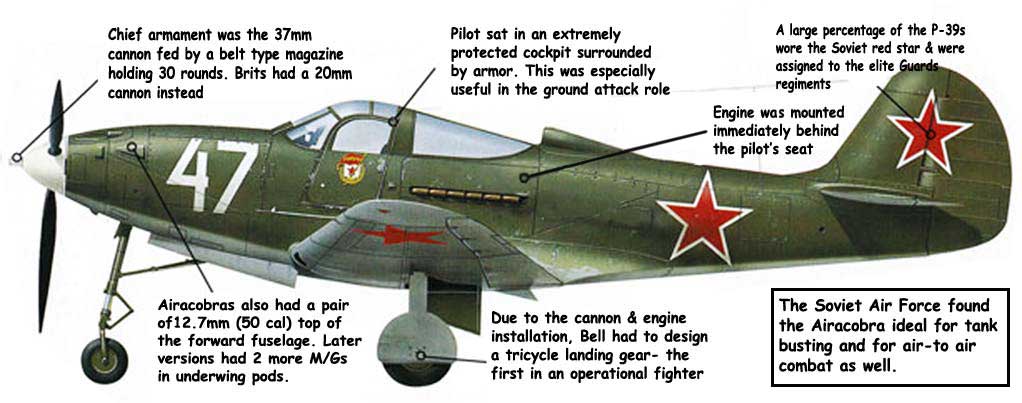A beautiful machine, XL! They were a world class fighter, equal to anything at the start of WW2. The Lightning was the result of an Army Air Corps specification for an
interceptor, a term they came up with so they could differentiate what they wanted from everything else available.
Two aircraft were designed to meet the specification: The Lockheed P-38 Lightning and the Bell P-39 Airacobra.

To meet the Army's specifications, Bell included a number of innovations: By mounting the engine in the center of the aircraft, the plane had less polar inertia and could turn faster. Weight was saved by using the main wing spar for the engine mount. The shaft drive engine permitted a tricycle landing gear with all of it's advantages, and not having a tail wheel enabled Bell to save on weight for the after part of the fuselage. The 30mm cannon was really a waste for air-to-air combat. Chuck Yeager said that it had a very arced trajectory and was worthless unless one was very close to the target. However, the Soviets, who used it for ground support, found it ideal for dealing with tanks.
So Bell tried to meet the specifications by making the plane as small and light as possible around the existing engine.
Kelly Johnson at Lockheed went the other direction: he used two engines. Because the Lightning was designed with counter-rotating engines, it did not have the torque problem that single engine fighters did, and by executing a full power shallow climb, the Lightning could escape from single engine fighters. The concentrated fire of the 4 x 0.50 BMGs and the 20mm copied Hisso cannon in the nose didn't require any convergence, so the Lightning's firepower could take pretty much anything in the air apart at any range. One downside was that the copy of the Hispano Suiza 20mm cannon (probably the finest air combat gun of WW2) was never perfected. While the originals worked very well, all of the American copies had a tendency to jam. Another problem with the Lightning was that in a steep dive, too much speed caused compressibility, which happens as an aircraft nears the sound barrier. This could cause the Lightning to loose control and crash. However the Lightning was very tough and maneuverable. One would not think so from looking at it, but it was. It also had a longer range than most fighters.
One thing to mention here has to do with the interaction of the turbocharger and the Allison V-1710 engine used in both the Lightning and the P-39 (and the P-40, as well). One thing the United States led the world in before and during WW2 was the development of turbochargers (or more correctly, "turbo-superchargers") and this was chiefly due to Dr. Sanford Moss of General Electric. Right after WW1, Dr. Moss began high altitude research on top of Pike's Peak in Colorado, which is over 14,000 ft above sea level. Many American aircraft were turbocharged, which gave them outstanding high altitude performance, but turbocharging was limited to bombers, except for the P-38 Lightning and the P-47 Thunderbolt.
The P-39 and P-40 were supposed to have turbochargers, too, but did not have them. Because of this, both aircraft were notoriously deficient at high altitude. But nobody ever complained about the high altitude performance of the P-38 and its turbocharged Allisons.
The problem here had to do with strategic materials: The chief producer of tungsten, which was necessary to make the exhaust turbine blades of the turbochargers survive high temperature, was Germany. Because tungsten was a strategic resource, only the bombers, the P-38s, and the P-47s got them. The P-51 Mustang, famously, got an engine swap and used Rolls Royce Merlins. While American engine research focused on turbocharging, Rolls Royce had put a lot of development into high altitude supercharging, giving the Merlin a large performance advantage over the Allison at altitude.
The P-38 Lightning is a wonderful aircraft, and one of the few (along with the de Havilland Mosquito) liquid cooled aircraft that I get enthusiastic about. (I am a round motor aficionado!)
Thanks for sharing this, XL. Wouldn't it make a wonderful toy?


